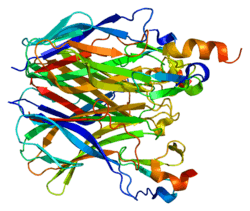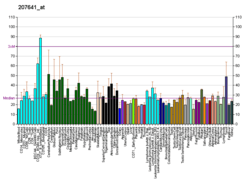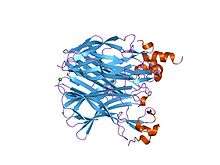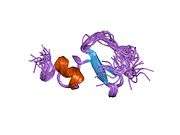Transmembrane activator and CAML interactor
Transmembrane activator and CAML interactor (TACI), also known as tumor necrosis factor receptor superfamily member 13B (TNFRSF13B) is a protein that in humans is encoded by the TNFRSF13B gene.
TNFRSF13B is a transmembrane protein of the TNF receptor superfamily found predominantly on the surface of B cells, which are an important part of the immune system.[5] TACI recognizes three ligands: APRIL, BAFF and CAML.
Function
TACI is a lymphocyte-specific member of the tumor necrosis factor (TNF) receptor superfamily. It was originally discovered because of its ability to interact with calcium-modulator and cyclophilin ligand (CAML). TACI was later found to play a crucial role in humoral immunity by interacting with two members of the TNF family: BAFF and APRIL.[6] These proteins signal through TACI inducing activation of several transcription factors including NFAT, AP-1, and NF-kappa-B which then modulate cellular activities. Defects in the function of TACI can lead to immune system diseases and has shown to cause fatal autoimmunity in mice.[7]
TACI controls T cell-independent B cell antibody responses, isotype switching, and B cell homeostasis.
Clinical significance
TACI mutations are associated with immunodeficiency in humans, as a significant proportion of CVID patients have TACI mutations. People with this condition produce abnormally low amounts of antibodies, which are needed for protection against infections.
In humans, the gene encoding this protein is located within the Smith-Magenis syndrome region on chromosome 17.[5]
TACI is currently being targeted for autoimmunity and B cell malignancies via atacicept, a recombinant fusion protein that binds the TACI ligands BAFF and APRIL.[8]
Interactions
TNFRSF13B has been shown to interact with B-cell activating factor,[9][10] TRAF6,[10] TRAF5,[10] TNFSF13,[6] TRAF2[10] and CAMLG.[10][11]
References
- GRCh38: Ensembl release 89: ENSG00000240505 - Ensembl, May 2017
- GRCm38: Ensembl release 89: ENSMUSG00000010142 - Ensembl, May 2017
- "Human PubMed Reference:". National Center for Biotechnology Information, U.S. National Library of Medicine.
- "Mouse PubMed Reference:". National Center for Biotechnology Information, U.S. National Library of Medicine.
- "Entrez Gene: TNFRSF13B tumor necrosis factor receptor superfamily, member 13B".
- Wu Y, Bressette D, Carrell JA, Kaufman T, Feng P, Taylor K, Gan Y, Cho YH, Garcia AD, Gollatz E, Dimke D, LaFleur D, Migone TS, Nardelli B, Wei P, Ruben SM, Ullrich SJ, Olsen HS, Kanakaraj P, Moore PA, Baker KP (November 2000). "Tumor necrosis factor (TNF) receptor superfamily member TACI is a high affinity receptor for TNF family members APRIL and BLyS". The Journal of Biological Chemistry. 275 (45): 35478–85. doi:10.1074/jbc.M005224200. PMID 10956646.
- Seshasayee D, Valdez P, Yan M, Dixit VM, Tumas D, Grewal IS (February 2003). "Loss of TACI causes fatal lymphoproliferation and autoimmunity, establishing TACI as an inhibitory BLyS receptor". Immunity. 18 (2): 279–88. doi:10.1016/s1074-7613(03)00025-6. PMID 12594954.
- Cogollo E, Cogollo E, Silva MA, Isenberg D (March 2015). "Profile of atacicept and its potential in the treatment of systemic lupus erythematosus". Drug Design, Development and Therapy. 9: 1331–9. doi:10.2147/dddt.s71276. PMC 4357613. PMID 25834391.
- Yan M, Marsters SA, Grewal IS, Wang H, Ashkenazi A, Dixit VM (July 2000). "Identification of a receptor for BLyS demonstrates a crucial role in humoral immunity". Nature Immunology. 1 (1): 37–41. doi:10.1038/76889. PMID 10881172.
- Xia XZ, Treanor J, Senaldi G, Khare SD, Boone T, Kelley M, Theill LE, Colombero A, Solovyev I, Lee F, McCabe S, Elliott R, Miner K, Hawkins N, Guo J, Stolina M, Yu G, Wang J, Delaney J, Meng SY, Boyle WJ, Hsu H (July 2000). "TACI is a TRAF-interacting receptor for TALL-1, a tumor necrosis factor family member involved in B cell regulation". The Journal of Experimental Medicine. 192 (1): 137–43. doi:10.1084/jem.192.1.137. PMC 1887716. PMID 10880535.
- von Bülow GU, Bram RJ (October 1997). "NF-AT activation induced by a CAML-interacting member of the tumor necrosis factor receptor superfamily". Science. 278 (5335): 138–41. doi:10.1126/science.278.5335.138. PMID 9311921.
Further reading
- Bossen C, Schneider P (October 2006). "BAFF, APRIL and their receptors: structure, function and signaling" (PDF). Seminars in Immunology. 18 (5): 263–75. doi:10.1016/j.smim.2006.04.006. PMID 16914324.
- Treml LS, Crowley JE, Cancro MP (October 2006). "BLyS receptor signatures resolve homeostatically independent compartments among naïve and antigen-experienced B cells". Seminars in Immunology. 18 (5): 297–304. doi:10.1016/j.smim.2006.07.001. PMID 16919470.
- Mackay F, Leung H (October 2006). "The role of the BAFF/APRIL system on T cell function". Seminars in Immunology. 18 (5): 284–9. doi:10.1016/j.smim.2006.04.005. PMID 16931039.
- Salzer U, Jennings S, Grimbacher B (January 2007). "To switch or not to switch--the opposing roles of TACI in terminal B cell differentiation". European Journal of Immunology. 37 (1): 17–20. doi:10.1002/eji.200636914. PMID 17171762.
- Maruyama K, Sugano S (January 1994). "Oligo-capping: a simple method to replace the cap structure of eukaryotic mRNAs with oligoribonucleotides". Gene. 138 (1–2): 171–4. doi:10.1016/0378-1119(94)90802-8. PMID 8125298.
- von Bülow GU, Bram RJ (October 1997). "NF-AT activation induced by a CAML-interacting member of the tumor necrosis factor receptor superfamily". Science. 278 (5335): 138–41. doi:10.1126/science.278.5335.138. PMID 9311921.
- Suzuki Y, Yoshitomo-Nakagawa K, Maruyama K, Suyama A, Sugano S (October 1997). "Construction and characterization of a full length-enriched and a 5'-end-enriched cDNA library". Gene. 200 (1–2): 149–56. doi:10.1016/S0378-1119(97)00411-3. PMID 9373149.
- Gross JA, Johnston J, Mudri S, Enselman R, Dillon SR, Madden K, Xu W, Parrish-Novak J, Foster D, Lofton-Day C, Moore M, Littau A, Grossman A, Haugen H, Foley K, Blumberg H, Harrison K, Kindsvogel W, Clegg CH (April 2000). "TACI and BCMA are receptors for a TNF homologue implicated in B-cell autoimmune disease". Nature. 404 (6781): 995–9. doi:10.1038/35010115. PMID 10801128.
- Xia XZ, Treanor J, Senaldi G, Khare SD, Boone T, Kelley M, Theill LE, Colombero A, Solovyev I, Lee F, McCabe S, Elliott R, Miner K, Hawkins N, Guo J, Stolina M, Yu G, Wang J, Delaney J, Meng SY, Boyle WJ, Hsu H (July 2000). "TACI is a TRAF-interacting receptor for TALL-1, a tumor necrosis factor family member involved in B cell regulation". The Journal of Experimental Medicine. 192 (1): 137–43. doi:10.1084/jem.192.1.137. PMC 1887716. PMID 10880535.
- Seshasayee D, Valdez P, Yan M, Dixit VM, Tumas D, Grewal IS (February 2003). "Loss of TACI causes fatal lymphoproliferation and autoimmunity, establishing TACI as an inhibitory BLyS receptor". Immunity. 18 (2): 279–88. doi:10.1016/s1074-7613(03)00025-6. PMID 12594954.
- Marsters SA, Yan M, Pitti RM, Haas PE, Dixit VM, Ashkenazi A (June 2000). "Interaction of the TNF homologues BLyS and APRIL with the TNF receptor homologues BCMA and TACI". Current Biology. 10 (13): 785–8. doi:10.1016/S0960-9822(00)00566-2. PMID 10898980.
- von Bülow GU, Russell H, Copeland NG, Gilbert DJ, Jenkins NA, Bram RJ (August 2000). "Molecular cloning and functional characterization of murine transmembrane activator and CAML interactor (TACI) with chromosomal localization in human and mouse". Mammalian Genome. 11 (8): 628–32. doi:10.1007/s003350010125. PMID 10920230.
- Wu Y, Bressette D, Carrell JA, Kaufman T, Feng P, Taylor K, Gan Y, Cho YH, Garcia AD, Gollatz E, Dimke D, LaFleur D, Migone TS, Nardelli B, Wei P, Ruben SM, Ullrich SJ, Olsen HS, Kanakaraj P, Moore PA, Baker KP (November 2000). "Tumor necrosis factor (TNF) receptor superfamily member TACI is a high affinity receptor for TNF family members APRIL and BLyS". The Journal of Biological Chemistry. 275 (45): 35478–85. doi:10.1074/jbc.M005224200. PMID 10956646.
- Yu G, Boone T, Delaney J, Hawkins N, Kelley M, Ramakrishnan M, McCabe S, Qiu WR, Kornuc M, Xia XZ, Guo J, Stolina M, Boyle WJ, Sarosi I, Hsu H, Senaldi G, Theill LE (September 2000). "APRIL and TALL-I and receptors BCMA and TACI: system for regulating humoral immunity". Nature Immunology. 1 (3): 252–6. doi:10.1038/79802. PMID 10973284.
- Novak AJ, Darce JR, Arendt BK, Harder B, Henderson K, Kindsvogel W, Gross JA, Greipp PR, Jelinek DF (January 2004). "Expression of BCMA, TACI, and BAFF-R in multiple myeloma: a mechanism for growth and survival". Blood. 103 (2): 689–94. doi:10.1182/blood-2003-06-2043. PMID 14512299.
- Hymowitz SG, Patel DR, Wallweber HJ, Runyon S, Yan M, Yin J, Shriver SK, Gordon NC, Pan B, Skelton NJ, Kelley RF, Starovasnik MA (February 2005). "Structures of APRIL-receptor complexes: like BCMA, TACI employs only a single cysteine-rich domain for high affinity ligand binding". The Journal of Biological Chemistry. 280 (8): 7218–27. doi:10.1074/jbc.M411714200. PMID 15542592.
- Moreaux J, Cremer FW, Reme T, Raab M, Mahtouk K, Kaukel P, Pantesco V, De Vos J, Jourdan E, Jauch A, Legouffe E, Moos M, Fiol G, Goldschmidt H, Rossi JF, Hose D, Klein B (August 2005). "The level of TACI gene expression in myeloma cells is associated with a signature of microenvironment dependence versus a plasmablastic signature". Blood. 106 (3): 1021–30. doi:10.1182/blood-2004-11-4512. PMC 2408610. PMID 15827134.
- Castigli E, Wilson SA, Garibyan L, Rachid R, Bonilla F, Schneider L, Geha RS (August 2005). "TACI is mutant in common variable immunodeficiency and IgA deficiency". Nature Genetics. 37 (8): 829–34. doi:10.1038/ng1601. PMID 16007086.
This article incorporates text from the United States National Library of Medicine, which is in the public domain.







